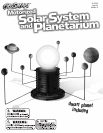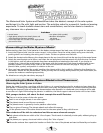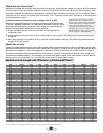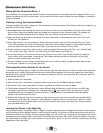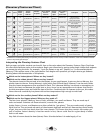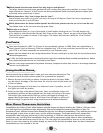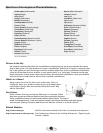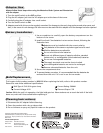
DATE Mercury Venus Earth Mars Jupiter Saturn Uranus Neptune Pluto
1/1/10 82º 275º 101º 117º 335º 179º 356º 326º 273º
2
/1/10 223º 324º 132º 131º 337º 180º 356º 326º 273º
3/1/10 303º 8º 161º 143º 340º 181º 356º 326º 273º
4/1/10 94º 58º 191º 157º 343º 182º 357º 326º 274º
5/1/10 226º 106º 221º 170º 345º 183º 357º 327º 274º
6/1/10 317º 156º 251º 184º 348º 184º 357º 327º 274º
7/1/10 113º 205º 279º 197º 351º 185º 358º 327º 274º
8/1/10 237º 255º 309º 212º 354º 186º 358º 327º 274º
9/1/10 331º 304º 339º 227º 357º 187º 358º 327º 274º
10/1/10 136º 351º 8º 242º 359º 188º 359º 328º 275º
11/1/10 249º 41º 39º 259º 2º 189º 359º 328º 275º
12/1/10 344º 89º 69º 276º 5º 190º 359º 328º 275º
1/1/11 157º 139º 100º 294º 8º 191º 0º 328º 275º
2/1/11 260º 189º 132º 313º 11º 192º 0º 328º 275º
3/1/11 353º 234º 160º 331º 13º 193º 0º 328º 276º
4/1/11 166º 283º 191º 351º 16º 194º 1º 329º 276º
5/1/11 262º 331º 220º 9º 19º 195º 1º 329º 276º
6/1/11 12º 20º 250º 28º 22º 196º 1º 329º 276º
7/1/11 179º 68º 279º 46º 24º 197º 2º 329º 276º
8/1/11 274º 118º 309º 63º 27º 198º 2º 329º 276º
9/1/11 34º 169º 338º 79º 30º 199º 2º 330º 277º
10/1/11 194º 217º 8º 094º 33º 200º 3º 330º 277º
11/1/11 285º 267º 38º 109º 36º 201º 3º 330º 277º
12/1/11 52º 314º 69º 122º 38º 202º 3º 330º 277º
1/1/12 208º 3º 100º 136º 41º 203º 4º 330º 277º
2/1/12 298º 053º 132º 150º 44º 204º 4º 330º 277º
3/1/12 71º 99º 161º 163º 47º 205º 4º 331º 278º
4/1/12 217º 150º 192º 176º 49º 206º 5º 331º 278º
5/1/12 304º 198º 221º 189º 52º 207º 5º 331º 278º
6/1/12 96º 248º 251º 204º 55º 208º 5º 331º 278º
7/1/12 227º 296º 280º 218º 58º 209º 6º 331º 278º
8/1/12 317º 345º 309º 233º 60º 210º 6º 332º 278º
9/1/12 287° 78° 339° 56° 324° 174° 354° 325° 272°
10/1/12 238º 82º 8º 266º 66º 212º 7º 332º 279º
11/1/12 332º 132º 39º 284º 68º 213º 7º 332º 279º
12/1/12 138º 181º 69º 302º 71º 214º 7º 332º 279º
1/1/13 249º 231º 101º 322º 74º 214º 8º 333º 279º
2/1/13 349º 280º 132º 341º 77º 215º 8º 333º 279º
3/1/13 148º 325º 161º 359º 79º 216º 8º 333º 280º
4/1/13 255º 14º 192º 18º 82º 217º 9º 333º 280º
5/1/13 354º 62º 221º 36º 84º 218º 9º 333º 280º
6/1/13 167º 112º 251º 53º 87º 219º 9º 333º 280º
7/1/13 263º 160º 279º 70º 90º 220º 10º 334º 280º
8/1/13 14º 211º 309º 085º 92º 221º 10º 334º 280º
9/1/13 184º 260º 339º 101º 95º 222º 10º 334º 281º
10/1/13 274º 308º 8º 115º 97º 223º 10º 334º 281º
11/1/13 36º 357º 39º 129º 100º 224º 11º 334º 281º
12/1/13 195º 45º 69º 142º 102º 225º 11º 335º 281º
Heliocentric Longitude (Planetary Address) Chart*
Where Are the Planets Now?
B
ecause the planets are constantly moving as they orbit the sun, their locations change from day to day. The motions
of the planets follow very regular patterns. Scientists can calculate where each planet will be at any given time.
One way to describe the positions of the planets is in terms of their heliocentric longitude. This is a coordinate system
with the sun as its center: the Greek root helio means “sun.” Scientists use the sun’s equator as a reference point
t
o locate objects in space.
A planet’s heliocentric longitude is given in degrees, from 0º to 359º.
Notice the numbered markings on the top and bottom of the central tower.
These are “planetary addresses” or heliocentric longitude markings. Using
these with the Heliocentric Longitude Chart below, you can arrange the
planets to closely approximate their current positions.
1. Locate the date nearest to the current date on the Heliocentric
Longitude Chart.
2. As you read across the row, you’ll see a number listed for each planet. This indicates the planet’s heliocentric
longitude.
3. Move each planet’s rod so that it lines up with the correct number marking. (The electrical power should be
turned off for this activity.)
Model Not to Scale
Explain to students that classroom solar system models cannot show planet sizes to scale. For example, the sun must
be shown much smaller in comparison to the planets than it actually is. In reality, the sun is about 108 times the Earth’s
diameter and is about 1 million times greater in volume: a million planets the size of Earth could fit inside it!
The distance between planets is also difficult to represent on a model. The planets are actually small compared to
the distances between them! If, for example, our model-sized dwarf planet Pluto were shown a correct relative
distance from our model-sized sun, it would need to be about 30 miles (48 km) away!
A
planet moves in two main ways. It rotates
(
spins) on its own axis. It revolves around, or
o
rbits, the sun. A “planetary day” is the length
o
f time a planet takes to completely rotate on
i
ts axis. The time it takes for a planet to
c
ompletely revolve around the sun is called a
“
planetary year.” See the “Creating a Living
S
olar System Model” exercise on page 3 and the
chart on page 4 for related information.
*Planetary addresses for years beyond the scope of this chart can be found at: http://planetarium.wvu.edu/heliocentric



